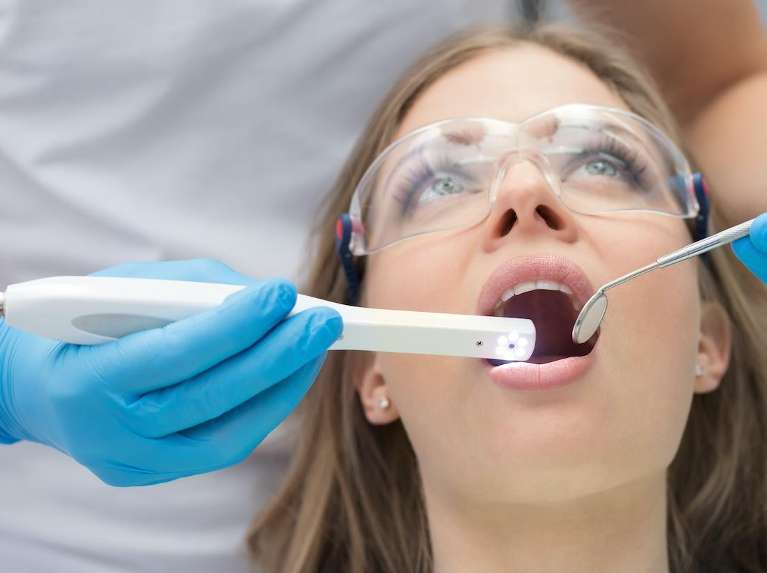At Heritage Dental, we've invested in leading-edge technology, from 3-D imaging to chairside scanners, to diagnose issues with greater precision, plan treatments with exceptional accuracy, and deliver care more comfortably than ever before. When we combine these modern technologies with our experienced, compassionate approach, we can achieve more predictable outcomes and significantly enhance patient comfort.

Digital X-Rays & Sensors
Instead of traditional film, modern digital x-rays use electronic sensors to capture detailed images of teeth and supporting structures. At Heritage Dental, this technology provides immediate high-resolution images with significantly less radiation exposure—up to 90% less than conventional x-rays.
Primarily used for detecting cavities, checking bone levels, and examining tooth roots, digital x-rays allow our dentists to diagnose conditions that would be invisible during a visual examination. You benefit from more accurate diagnoses, reduced radiation exposure, and the ability to see and better understand your oral health conditions.

CBCT Cone Beam Technology
CBCT (Cone Beam Computed Tomography) creates detailed 3-D images of teeth, bone, nerve pathways, and soft tissues in a single scan. This advanced technology provides comprehensive views from multiple angles, essential for complex procedures like dental implant placement, root canal therapy, and orthodontic planning.
Our dentists use these precise images to plan treatments with exceptional accuracy. You benefit from more predictable outcomes, reduced procedural time, minimally invasive treatments, and clearly visualized treatment plans that help you understand complex dental conditions and recommended procedures.

Digital Impressions
Digital impression technology uses optical scanning to create precise 3-D models of teeth and gums without messy conventional impression materials. The process involves a small scanner that captures hundreds of images assembled into an accurate digital model of your mouth.
Heritage Dental uses this technology for crowns, bridges, veneers, Invisalign, and other custom dental work. Patients benefit from a more comfortable experience without gagging on traditional impression material, highly accurate restorations with better fit, fewer adjustments needed, and often faster turnaround times for their dental work since models can be immediately sent to dental labs.

Intraoral Cameras
An intraoral camera is a small, pen-shaped device that captures high-resolution images inside your mouth and displays them instantly on a screen. These cameras provide detailed views of teeth, gums, and restorations that would otherwise be difficult to see. Intraoral cameras help identify cracks, plaque buildup, and failing restorations during dental examinations. You can see what the dentist sees, so you can better understand your treatment needs and our recommendations, and make more informed treatment decisions. We also use this technology to show you the results of dental work before and after treatment.

Panoramic X-Rays
Panoramic x-rays capture a complete view of the mouth in a single image, including all teeth, jaws, sinuses, and temporomandibular joints. Heritage Dental uses this technology for comprehensive evaluations, orthodontic assessments, tooth extraction, and identifying bone abnormalities or pathologies.
The process is comfortable—you simply bite on a small positioning device while the machine rotates around your head. Benefits include a complete overview of oral structures, reduced radiation compared to multiple traditional x-rays, enhanced diagnostic capabilities, and simplified treatment planning for complex dental issues.

Nitrous Oxide or "Laughing Gas"
Nitrous oxide (laughing gas) is a mild sedative gas mixed with oxygen and administered through a small mask placed over the nose. This safe, effective sedation method helps anxious patients remain calm and comfortable during dental procedures without full unconsciousness.
Commonly used for everything from routine cleanings to more complex treatments, nitrous oxide takes effect quickly and wears off rapidly after treatment. Patients benefit from reduced anxiety, increased comfort, consciousness that allows communication with the dentist, and the ability to drive themselves home afterward, making dental visits accessible for those with dental phobias.

Digital Records
Digital records replace traditional paper charts with comprehensive electronic documentation of patient information, treatment history, images, and notes. Heritage Dental's secure digital record system maintains detailed information accessible to the entire dental team while protecting patient privacy.
Used for tracking treatment progress and maintaining accurate histories, digital records enhance continuity of care. Patients benefit from more coordinated treatment, faster access to their dental information, improved security of personal data, and seamless communication if specialty referrals are needed.